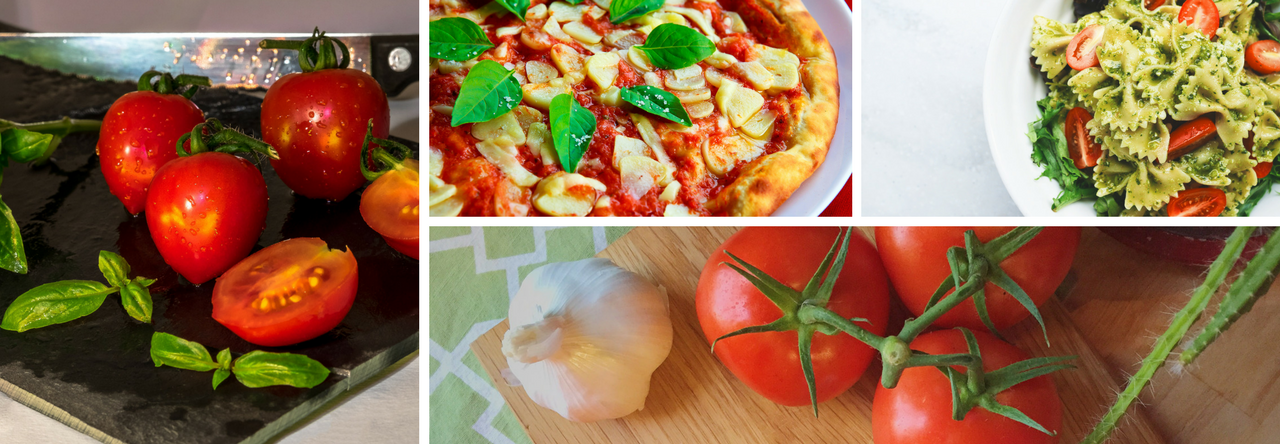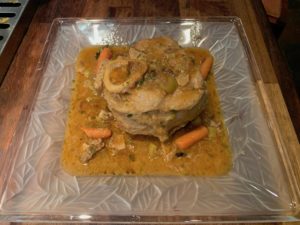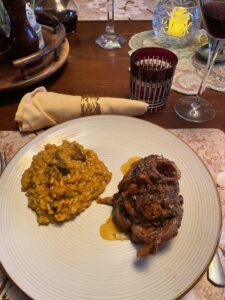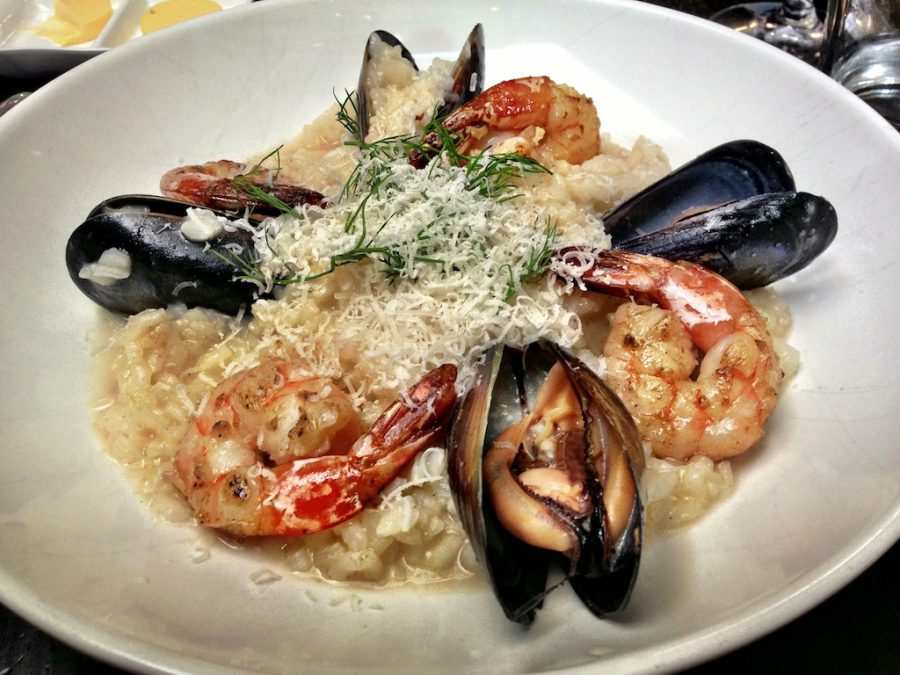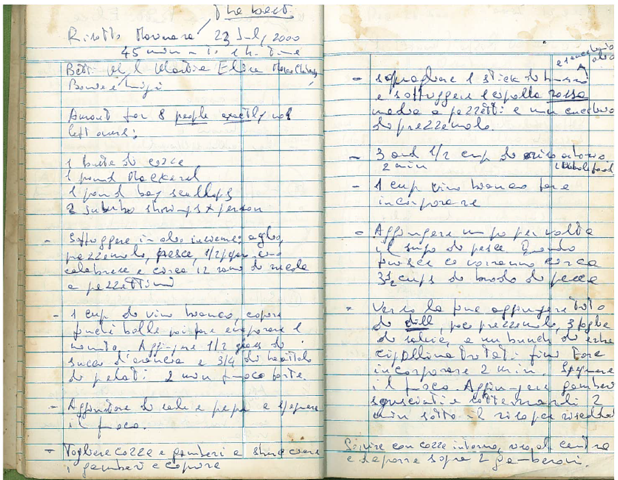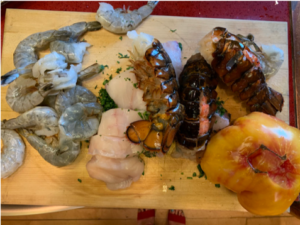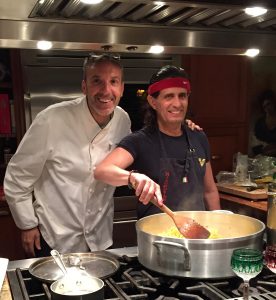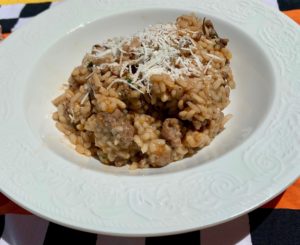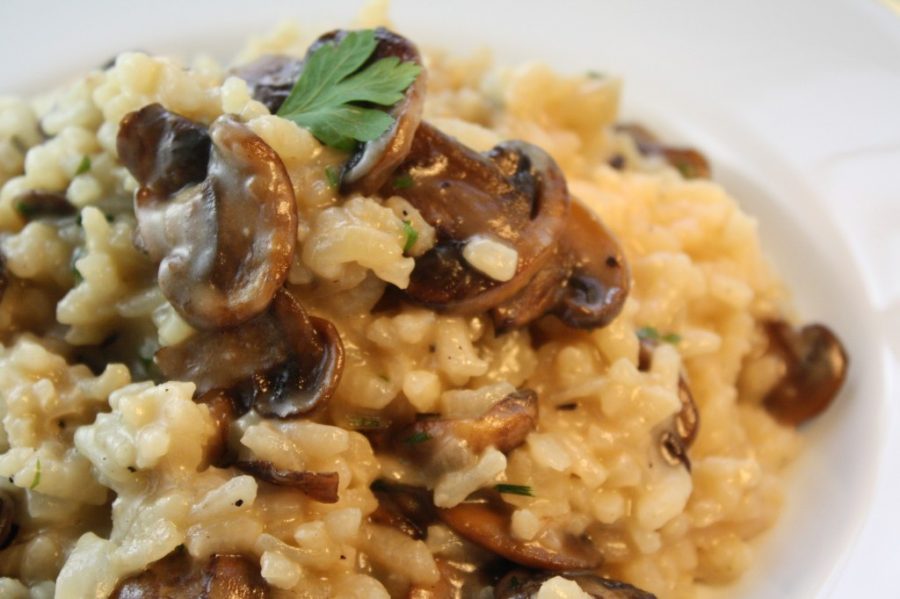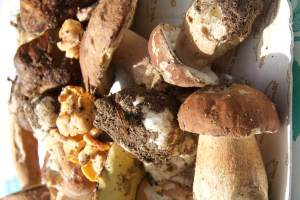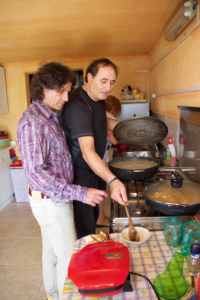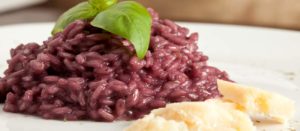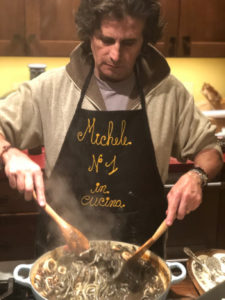Spigola (Branzino) Roasted with Zucchini (Spigola di Gualtiero Marchesi)
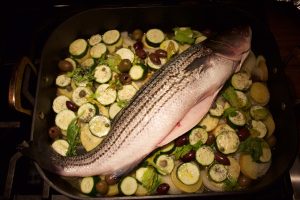
Michele Carbone roasted this sea bass on a bed of zucchini and celery, a recipe inspired by the great Italian chef Gualtiero Marchesi
This is one of my preferred dishes. I learned it in a restaurant near Brescia many years ago; the Chef was Gualtiero Marchesi, the most famous Italian Chef for the past 50 years. This is the absolutely best way to eat a spigola, and this is from someone (me) who spent his youth spear-fishing for spigola!
I learned from Marchesi’s cook books that cooking is something simple: it requires fresh ingredients, it requires the best ingredients, but it does not require complicated and fatty sauces that kill the flavor of the food you eat, and with that kill also your liver. His was Italian cuisine at its best, a cuisine you can enjoy every day without putting on weight. Marchesi used to say that his hope was that at least one of his dishes would be remembered over the centuries. Well, among them I choose this one.
This recipe works best for spigola (in the US ,this fish is called branzino) ,but it is perfect for any fish. It works also when using fish filet—grouper or snapper (better)—in which case, of course you need to change the cooking time (see below).
Ingredients for 4 people
- 4 branzino weighing about 1 pound each
- Sweet onions cut ½ cm thick
- Yukon potatoes cut ½ cm thick
- Zucchini, slicked in rounds about 1 cm thick
- Celery fronds—yes, those leafs that unfortunately are often cut away in US grocery stores, so you need to ask them to give you a celery with the leafs, or buy 3 bunches and look for the leafs inside the celery that were not cut out
- ½ pound cherry tomatoes, preferably a mix of red and yellow, minced in a food processor (optional)
- 2 tablespoons of capers
- 1 handful of olives
- 1 cup: 2/3 of water, 1/3 of olive oil mixed well. Use hot water so it mixes easily).
Preparation
- Preheat oven at 400 F (or 200 C), convection
- Brush olive oil on a rectangular roasting pan that’s big enough for the four branzino.
- Put first a layer of onions to cover the bottom, then a layer of potatoes, then a layer of zucchini, then a layer of celery leaves, then sprinkle all over with the tomato, add olives and capers, salt and pepper, and sprinkle all over with the water/oil mix.
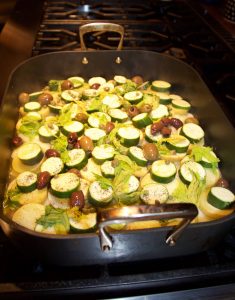
A bed of zucchini, celery and olives
- Cover, sealing as best as you can with aluminum foil.
- Cook these vegetables in the oven for 10-20 minutes if you are cooking a whole fish, or for 40 minutes if you are cooking the fish fillet – IMPORTANT: YOU WILL ADD FISH IN THE NEXT STEP!
- Remove the roasting pan from the oven, add the fish, cover again with aluminum foil, and put it back in the oven for another 25-40 min (for the whole fish depending on size, for example, a 3 pound striped sea bass cooked for 40 minutes), or for about 8 minutes for a fish filet.
- Enjoy!
If you use a different type of fish–for example grouper or snapper (better)–lengthen the cooking time by 5 to 10 minutes, depending on the size of the fish.
Italiano: Spigola di Gualtiero Marchesi
Spigola di Gualtiero Marchesi, il Re degli Chef Italiani per gli scorsi 50 anni: Questa è la mia ricetta preferita per cucinare la spigola, ma va bene anche per altri pesci, se usate filetti di pesce I tempi di cottura vanno cambiati.
Ingredienti per 4 persone
- 4 branzino del peso di circa 1 libbra ciascuno
- Cipolle dolci tagliate spesse ½ cm
- Yukon patate tagliate ½ cm di spessore
- Zucchine, tagliate a rondelle dello spessore di circa 1 cm
- Fronde di sedano: sì, quelle foglie che sfortunatamente vengono spesso tagliate nei negozi di alimentari statunitensi, quindi devi chiedere loro di darti un sedano con le foglie, oppure comprare 3 mazzi e cercare le foglie all’interno del sedano che non sono state tagliate su
- 225 grammi di pomodorini, preferibilmente un misto di rosso e giallo, tritati in un robot da cucina (opzionale)
- 2 cucchiai di capperi
- 1 manciata di olive
- 160 ml di acqua, 80 l di olio d’oliva mescolato bene. Usa l’acqua calda in modo che si mescoli facilmente.
Preparazione
4 spigole di circa 200 g. cioè una a testa, se piatto unico, oppure se avete fatto un primo con 4 spigole servite otto persone.
Riscaldare il forno a 200 C (400 F), convection.
Ungere teglia da forno di grandezza sufficiente per le 4 spigole con olio di olive.
- Coprire il fondo della teglia con uno stato di cipolle dolci, tagliate a rondelle di ½ cm.
- Seguire coprendo con uno strato di patate tagliate a rondelle di ½ cm.
- Seguire coprendo con uno strato di zucchine tagliate a rondelle di 1cm.
- Coprire con le foglie (solo foglie) di sedano.
- Aggiungere 200 g di pomodori maturi tritati per qualche secondo nel robot da cucina–ma non esagerate fino a farli diventare liquidi!
- Aggiungere un pugno di capperi e due pugni di olive.
- Aggiungere 160 ml di acqua, 80 l di olio d’oliva mescolato bene.
- Coprire con foglio di alluminio e infornare nel forno già a temperature di cottura per 10-20 minuti –o 40 minuti se usate filetti di pesce.
- Togliere la teglia aggiungere le spigole –o filetti di pesci- e re infornare (per 25 -40 minuti se pesce intero o per 8 minuti se usate i filetti).
Se usate un pesce differente dalla spigola, per esempio l’orata ci sta benissimo allungate la cottura di 5-10 minuti, dipende dalla grandezza del pesce.
È una ricetta semplice e meravigliosa.

